In Volleyball there are three main formations that teams use.
The three formations in volleyball are as follows:
Table of Contents
Three Volleyball Formations
- 4-2 Volleyball Formation
- 5-1 Volleyball Formation
- 6-2 Volleyball Formation
The numbers in each formation represent the number of hitters and setters in each formation.
So in the example of the 5-1 formation, The 5 means there are 5 hitters and the 1 indicates that there is 1 setter on court at all times.
In this article I am going to focus solely on the 5-1 formation and by the end of the article I hope you will leave with everything you need to know about this formation.
In this article I am going to cover what the 5-1 formation is, the advantages and disadvantages of this formation over the others and lastly how to stack and rotate when you are the serving team as well as when in serve receive.
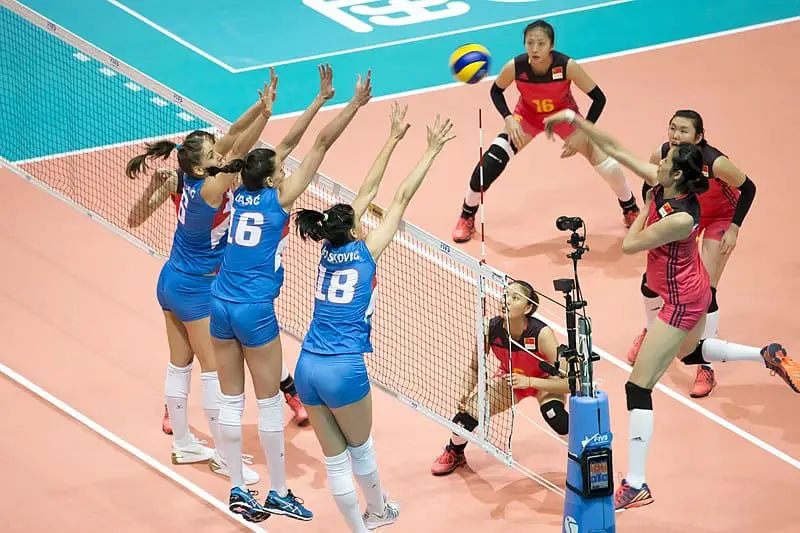
By the end of this article you will have the rotations down, once you have finished this article head back up here and get your volleyball essentials from Amazon
What Is The 5-1 Volleyball Formation
So kicking off the article I want to just go over once more exactly what the 5-1 formation is and what players you might find in each position.
So as mentioned above the 5-1 formation has 5 hitters and only 1 setter.
Unlike the other formations this means the setter must set whether they are front court or back court.
As you know when teams line up they must be opposite to the other player who plays the same position.
For example if the middle blocker is in the middle of the court in the front row, the 2nd middle blocker will also be in the middle of the court but in the back row.
So obviously as we only have 1 setter in this formation we need to introduce another player to stand opposite the setter.
This player coincidentally is actually called the opposite (Sometimes referred to as the right side hitter). The opposite as the second name suggests is a player that attacks from the right side of the court.
This includes the front court and back court.
When in the front row the opposite will attack from position 2 (Front right position) and when in the back row they will hit the ball from the back court from position 1, this is often known as a 10 ball or 10 attack.
The players in this formation are as follows:
- Setter
- 2no. Middles
- 2no. Outside hitters
- Opposite (Right Side Hitter)
The 5-1 is the most commonly used formation across volleyball and is often seen at higher levels of volleyball and is widely used in the professional game.
Advantages of The 5-1 Volleyball Formation
Provides the Most Setting Options & Creativity
One of the main advantages at least in my humble opinion is just the amount of creativity it gives the team and sheer number of setting options available.
Running this formation allows for elaborate players and clever sets like no other.
As a setter it offers a lot of freedom and when the pass is consistent there really isn’t anywhere on the court that you can’t set.
This makes it extremely hard for the opposing team to line up any good blocks or even set up a solid defensive line.
A team running a well executed 5-1 can cause a defending team an awful lot of problems.
Builds Strong Relationships Between Hitters & Setters
Another massive benefit to this formation is because the setter is always the same player, it can lead to great understanding and a strong relationship between setter and hitter.
As a hitter knowing that the setter is always at the same tempo and can always hit the sweet spot with their set is a massive confidence boost.
I feel like this relationship is particularly important between middle hitters and setters.
When a middle is running in like the speed of lighting it is so vital that as a setter you know exactly where to put the ball otherwise the middle will have to play a safety shot or maybe even miss the ball completely.
In Volleyball there is no better example of this relationship than Bruno and Lucas the Brazilian Internationals
Another fantastic advantage that relates to this point is having the same setter allows a team to keep to the same tempo with their play.
Again this just means that all hitters know almost to the millisecond the timing for their jumps making their attacks a lot more effective.
When a team finds their rhythm and tempo it can be really difficult to slow them down.
Improves Consistency
Touching on the above point the hitters become a lot more consistent because they know the timing and speed of the set.
This formation also means that all players get a lot of repetitions in their preferred positions.
This is particularly true for the setter.
Unlike the other formations where the setter only sets half the time.
This rotation allows the setter to get lots of repetitions which can only lead to good things when it comes to consistency.
3 Attackers For Half Of The Rotations
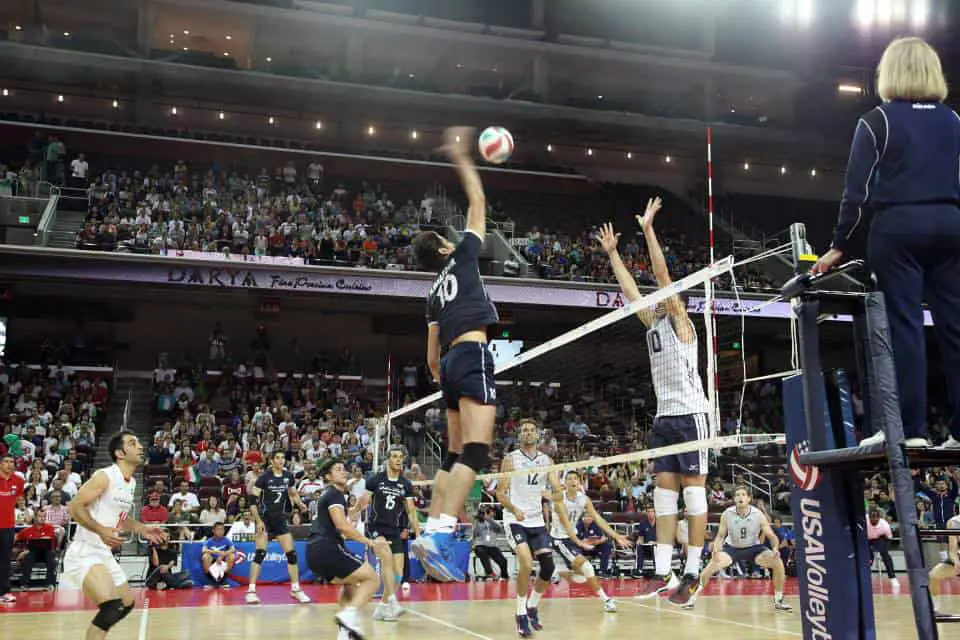
The last point could honestly go in either the advantages or disadvantages.
If you compare this formation to the 4-2 then it can only be seen as an advantage however it does fall short to the 6-2 Formation.
The advantage I am referring to, is of course the fact that in half of the rotations there are 3 front court hitters.
Having 3 front court hitters can be very dangerous especially when paired with a good deceptive setter.
Having 3 front court hitters causes hesitation in the blocking team as they can’t be sure which player is going to be set.
Couple this with a deceptive setter and you can find the hitters in lots of 1v1 situations which as we know in Volleyball is almost always a guaranteed kill.
Disadvantages of The 5-1 Volleyball Formation
Can Create Weaknesses In Defense
No admittedly high level players and teams probably won’t let this happen however I have seen it on more than one occasion and truth be known as a setter I have even been guilty of it myself.
When the setter is back court obviously they want to try and creep forward ready to set the ball on the second touch.
The main problem with this is it leaves a weakness in the defense at position 1.
As the ball is about to be hit by the attackers if the setter starts creeping forward too early and the opposition spike the ball to position 1 it is going to be very hard to pick up that ball.
Even if this situation doesn’t occur but the middle back player thinks it might, it may cause the middle back player to try and help the setter too much and leave a weakness in the middle of the court.
Disciplined teams shouldn’t have this issue but it certainly is something I have seen happen and so is worth noting.
Difficult For Beginners To Learn & Remember All Rotations
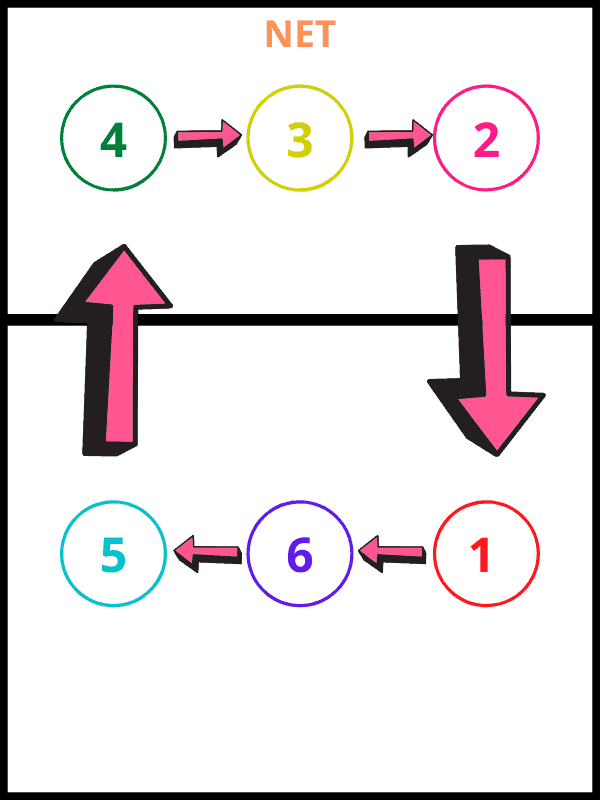
The other obvious drawback to this formation is not only the number of rotations but also the fact they are quite complicated and confusing.
Obviously you will see these in a second when we dive into the diagrams, but unlike both the 4-2 and the 6-2 there are actually 6 rotations to learn with this formation.
Rotations are often a point of contention for new players anyway so when there is 6 rather than 3 it can be very overwhelming.
This is the main reason why this formation is not often seen at the lower level and often saved for more advanced or high level play.
General Rules of Thumb When Running The 5-1 in Volleyball
All Players Need To Be Ready To Attack
I touched on this earlier when I spoke about the advantages but I feel in this formation more than any other it is important that every player is ready to attack the ball whether they are front or back court.
This formation remains so effective as there are so many different ways to catch defensive teams out by having attackers hit the ball from different heights, positions and even speed.
By ensuring every player is ready to hit it not only makes the opposition’s life extremely difficult but also means if the first pass isn’t on target the setter still has options to salvage the ball and the point.
When Setter Is Back Court 6 Player Needs To Try & Cover More
This point slightly contradicts my point earlier however I do think it is important that where possible the player in the deep 6 position is prepared to cover the setter when they are back court.
If the ball is hit high and loopy meaning the 6 player has time to take the ball I feel they definitely should step in to allow the setter to get ready to set up the attackers.
Obviously if the opposition are swinging hard then the setter will have to stay firm and play defense above all else.
On Free Balls 2 Player Needs To Switch With Setter For Defensive Duties
In this formation when the setter is back court we obviously want them to avoid taking the first ball.
Apart from the 6 player covering a bit more ground there is actually something much more clever we can do with the player at position 2 (The opposite)
When we know the opposition are not spiking the ball and it is likely going to be a free ball the setter and opposite can actually quickly swap positions.
Not only does this prevent the setter taking the first ball and allows them to get in position but it also puts the opposite in a better position to start their attacking approach.
Next time your team plays this formation try incorporating this and I promise it will do wonders for the offense.
Serve Rotations 5-1 Formation
When it comes to starting serving I often like to start with Setter as the first server as this allows the team to have 3 dedicated front row players that will all likely be good blockers.
Starting like this also allows the team to have three rotations where there are 3 dedicated front players for attacking.
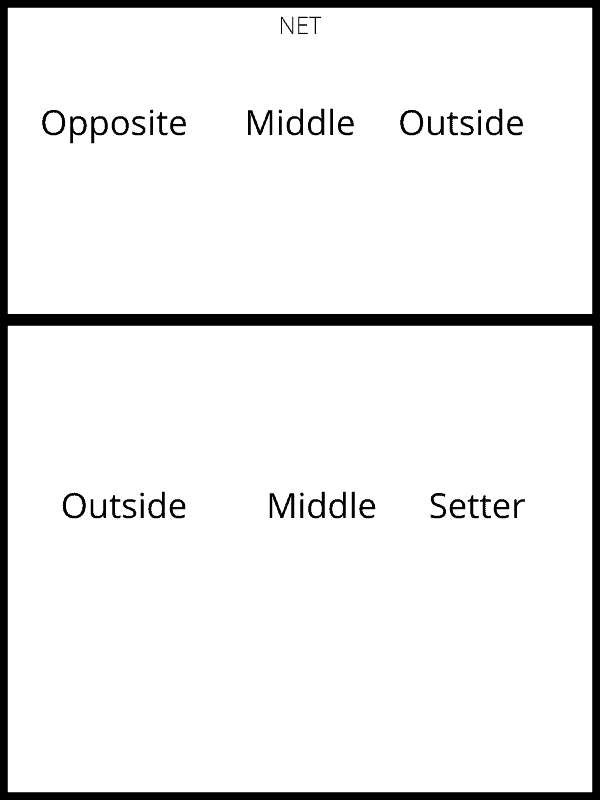
Based on the above this is how the team would lineup on court.
5-1 Serving – Rotation 1
In rotation 1 as I said we have our setter starting us off serving.
The setter when back court plays position 1 (The back right position). This allows them to have the shortest distance to get their preferred setting position.
This may be controversial and your coach may line you up differently but personally when not using a Libero I like to have the Middle Blocker play position 5 (Back Left position) rather than position 6 (Middle Back). Based on This in all these rotations I will show the middle at position 5 and the outside at position 6.
In the front row we obviously want our outside hitter to be at position 4 (Front left), our middle at position 3 (Middle front) and the opposite or right sided hitter at position 2 (Front Right).
The easiest way to get all players into their preferred positions is by having the middle and outside in the back row to stand next to each other near the middle of the court, ensuring the outside is to the left of the middle and the middle is to the right of the outside to prevent breaking the rules of rotation.
For the front row we want our outside and opposite to swap sides, as a general rule of thumb we always want our middle blocker to be in the middle and closest to the net, this way they can be ready to block any quick attacks or punish any teams for overpasses.
With this in mind we will have our players all stand next to each other up by the net and in the centre.
This allows the middle to be in position already, the outside will stand to the right of the middle and the opposite will stand just to the left of the middle.
The second the ball is served all rotations will take place.

5-1 Serving – Rotation 2
Rotation 2 is a nice simple one as there is really only one player that needs to rotate.
Although there are actually more players that aren’t lining up in the correct location there is only one player that can’t start in their desired location.
The opposite who is in the front row needs to swap locations with the middle, however as I said earlier we always want our middle to be in the middle where possible and closest to this net.
The way in which we achieve this is by bringing the middle to the centre of the court and placing the opposite just to the left side of the middle ready to run past them to position 2.
In the back row we have the outside serving and we obviously want to get the setter to position 1 not position 6.
As the outside who would be at position 1 is serving and not on the court at the time they actually don’t fall under any rotation rules.
This means the setter can simply start in their preferred location at 1 and the outside can serve and walk onto the court in the middle back position.
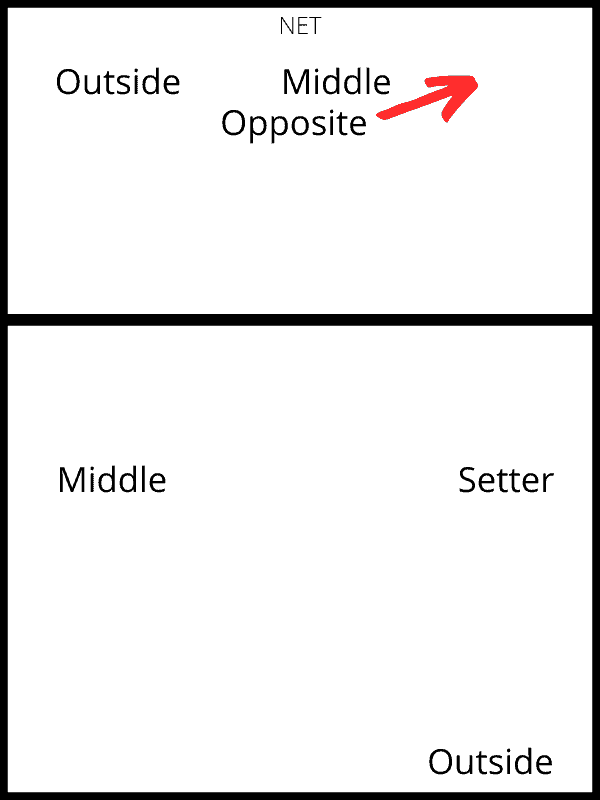
5-1 Serving – Rotation 3
Moving onto rotation 3 we have the middle up to serve.
Firstly the middle who is playing back court in position 5 would most likely want to serve from the left side to avoid them having to serve from the right and run across the whole court.
Regarding the back row we need to get the setter over the other side of the court to position 1.
The outside can start at position 6, this allows the setter to move closer to position 1 ensuring they stay to the left of the outside.
In the front row we need to swap the outside player and the middle.
Again the middle will push towards the centre of the court and stand close to the net ready for any quick attacks.
This means the outside who must start to the right of the middle will stand just off the shoulder of the middle and run behind them to position 4 as soon as the ball is served.

5-1 Serving – Rotation 4
Hopefully these next three rotations will look similar as essentially they are the same as the first 3 however this time the setter is front court and the opposite player is back court.
So again the middle and outside will want to swap positions in the back court, this means the middle and outside will stack next to each other near position 6 so once the ball is served the middle can run forwards and left to position 5 leaving the outside next to their position at deep 6.
In the front row we are back to the rotation where we need to completely flip the lineup.
This means the setter needs to get to position 2 and the outside needs to get to position 4.
The middle will stand up close to the net in the middle and the setter will stand off their left shoulder with the outside off the middles right shoulder.
Once the ball is served the outside and setter will swap positions and get ready to block.
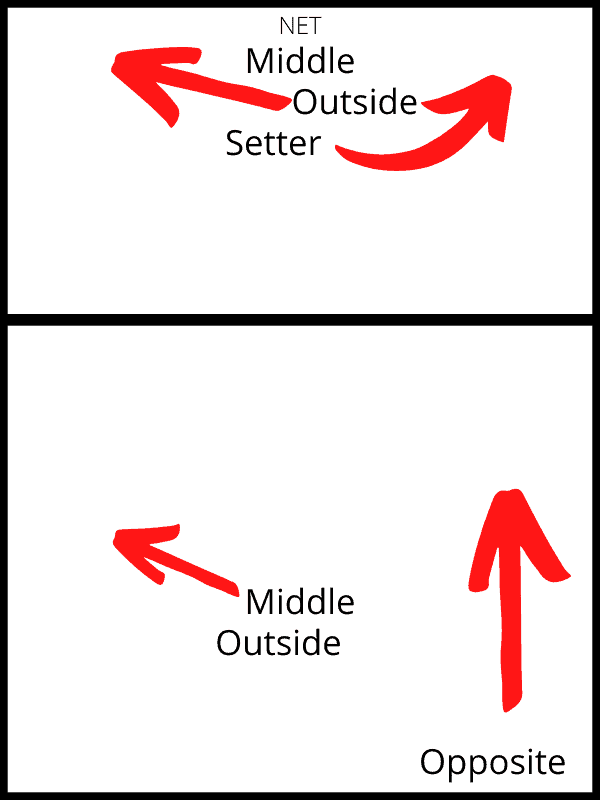
5-1 Serving – Rotation 5
Rotation 5 much like rotation 2 although it has a few players out of their preferred positions it only requires one player to physically run to a new location.
The outside who is serving will be playing position 6, as they are off the court the opposite can stand directly in their preferred spot at position 1.
In the front row the setter and middle need to swap locations.
To achieve this the middle will come into the centre of the court to their preferred location meaning the setter who will be just to the left of the middle will need to wait until the serve has taken place and run behind the middle to position 2.
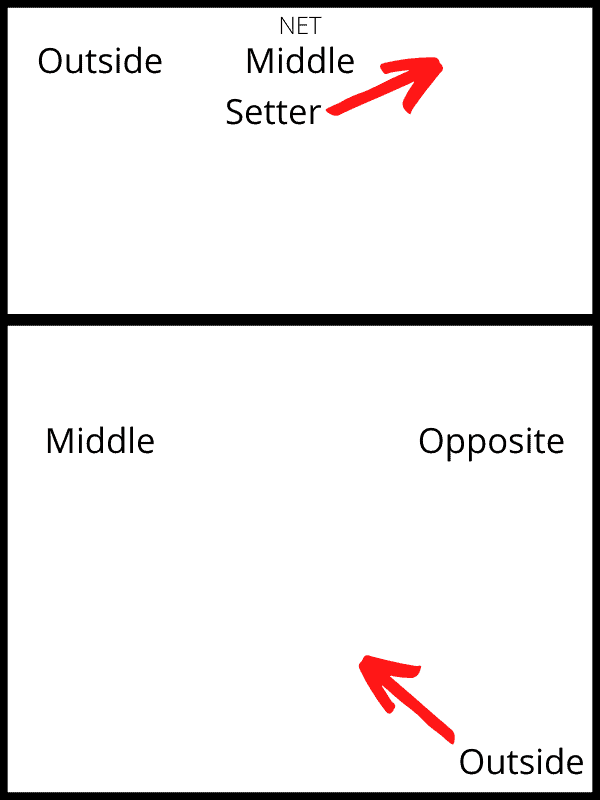
5-1 Serving – Rotation 6
Moving on to the last rotation we are back to the middle serving again.
As mentioned before it makes sense for the middle to serve from the left side of the court so they can walk on straight into their position.
In the back row we need the opposite to get over the otherside of the court so they will stand just to the left of the outside in position 6 ready to run over to position 1.
In the front row we need to get the outside to swap with the middle.
By dragging the middle towards the centre of the court and starting them in their preferred position it leaves only the outside with a little run.
The outside will stand just to the right of the middle and the second the ball is served they will run into position 4 ready to block.

There you have it every rotation for when you are the serving team in the 5-1 formation.
Serve Receive Rotations 5-1 Formation
Okay so I will level with you.
I started with the easier rotations and now we are moving on to the more complicated set.
A common starting lineup for the a team using this formation that is receiving first would as follows

So starting off we have rotation 1, now I will warn you, you are going to see a lot of arrows on these diagrams but hopefully I can help you through them.
5-1 Serve Receive – Rotation 1
In rotation 1 we are going to leave our setter in their preferred position at 2 so they can be ready to set.
Opposite the setter we obviously have the opposite, now it is quite common for the opposite to be pushed out of the pass, the main reason for this is to allow the opposite to focus on hitting.
The opposite also protrolls the back line to let the rest of the team know whether the ball is going in or out.
So if we push the opposite out of the pass we are left with just two passers which isn’t really an efficient passing line.
To counter this we actually want to bring the outside hitter who is in position 3 (Front Middle) back into the passing line.
In the rules of rotation this outside player can not go behind the player who is opposite them in the back row (In this can it’s the 2nd outside), they can’t cross to the left of the middle and they can’t cross to the right of the setter.
Based on this if we push the middle as far left as we can the outside can actually come back and pass in the opposites position.
So long as they don’t cross left of the middle or behind the 2nd outside.
Once the ball has been served and one of our passers who played the ball to the setter the rotations can take place.
The middle stood in the top left corner will start wrapping their run towards the middle position ready to hit, the outside will step forward and start heading towards the position that the middle was just standing.
In the back row the opposite will have to run around the back of all the back court players to position 1 (Bottom right) to get ready for a back court attack.
The 2nd middle in the back row will need to run across the whole court to get to position 5 (Bottom Left).
As I mentioned above I have the middle player in position 5 and the outside player in position 6 (Middle Back)
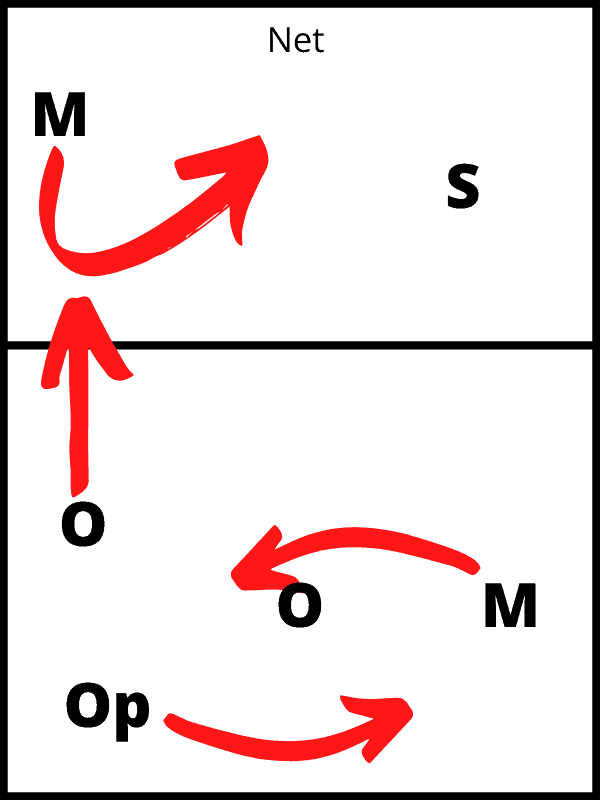
5-1 Serve Receive – Rotation 2
Moving onto rotation 2 the setter is actually now back court, obviously we don’t want them in the pass as we want them ready to set the second ball.
The easiest way to get round this is by pulling the outside player currently at position 2 (Front right) back to the passing line to step in for the setter.
The outside player can freely move back providing they don’t fall behind the setter or cross to the left of the middle at position 3.
Just to give a clear view of the serve the middle and opposite will likely stack near the left side of the court to ensure the passers can see clearly.
Once the ball has been served in and passed up the setter will run round the outside passing in front of them to their setter base position, the outside who came back to help pass will move outwards towards the right sideline and forwards ready to hit through the right wing.
In the back row the middle and 2nd outside just simply need to switch positions.
This rotation is unlike any other as it is often much easier to leave the opposite hitting through position 4 (left wing) and the outside hitting through position 2 (right wing) to prevent complicated position switches.

5-1 Serve Receive – Rotation 3
Moving onto rotation 3 we again have the setter in the back row but we don’t want them passing the ball. In the middle back position (Position 6) the setter is affected by the players either side of them at position 1 and position 5, they are also affected by the player directly in front of them at position 3.
What this means is the setter can’t cross to the left of the middle at position 5, can’t cross to the right of the outside at position 1 and they can’t go in front of the opposite at position 3.
With this in mind we can actually push the setter forwards to the net and out the way of the pass.
To ensure we can move the setter the opposite player must stand right up tight to the net.
It is common for the opposite and middle players to move nearer the right side line, this way the setter can stand almost in the perfect spot and the middle and opposite have the shortest distances to run to get to their favourite hitting positions.
Again we are down a passer in the back row.
To counter this we will push the middle player who was to the left of the setter in the back row into the middle to take the pass for the setter.
To fill the gap where the middle has moved from we will pull the outside who has just moved front court, back into the pass to give us our three passers.
The outside when coming back must ensure they stay a step in front of the middle they are passing next.
Once the ball is served and passed up the opposite will run towards position 2, the middle will wrap round the setter ready to hit in the middle.
The outside who dropped back to pass will move forward to position 4 and the two back row players will both step right to get their defensive positions.

5-1 Serve Receive – Rotation 4
Rotation 4 is a bit of a confusing one to get your head around at first.
The setter is still in the back row so again we don’t want them in the pass so we will push them forward towards the top left corner.
The outside who is currently front court in the middle at position 3 will have to come back and pass in place of the setter.
This outside must make sure they don’t cross to the left side of the middle who is stood in position 4 next to them, they must also make sure when they come back to pass they don’t stand behind the outside player who is currently back court.
To assist with this the middle and setter will stand nice and tight to the left side line and in the corner to ensure the passers have good visibility of the serve.
Once the ball is served and passed up the setter will run to position 2.5 (Area between position 3 and position 2) ready to set, the outside who came back to help pass will step forwards towards position 4 ready to hit and the middle will wrap backwards and towards the middle of the court again ready to hit.
In the back row the outside player is already stood in the correct defensive position leaving just the middle to run across the backline to get to position 5
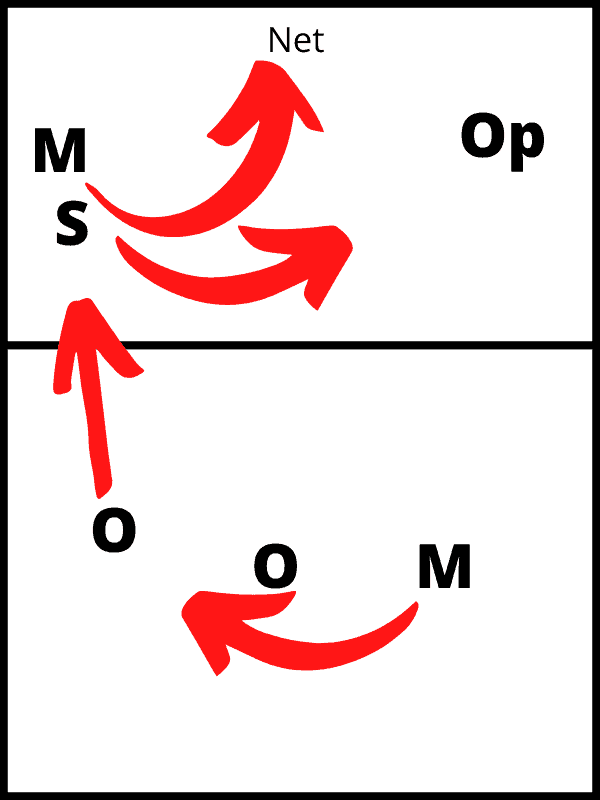
5-1 Serve Receive – Rotation 5
This rotation is certainly one of the more awkward ones however it is relatively straightforward to understand.
The setter has now moved front court and the opposite is now in the back row.
Again we don’t want the opposite to pass so they can focus on hitting, to hide the opposite we will push the middle who is in position 6 round to pass in front of the opposite.
As we push the middle round we also push the outside round towards position 6 to pass where the middle has moved from.
This leaves a gap at position 5 where we are short of a passer.
Just like all the other rotations we are actually going to pull the front court outside player back in to pass.
As they are currently standing at position 2 (Front right) and can not cross the left side of the middle we obviously need to bring the middle as far over left as we can to ensure the outside player can still have a good passing position.
As we bring the middle over we can’t have the middle cross to the left of the setter, so again the setter will also stand as close to the left side line as possible.
Once the ball has been served and passed the setter will run across the court to position 2.5 to set the ball, the middle will drop back and wrap round ready to hit in the middle, the outside will move forwards towards position 4.
In the back row the middle player needs to swap sides of the court so they will move across to position 5 ready for defense and the opposite will step forward ready for any backcourt attacks.
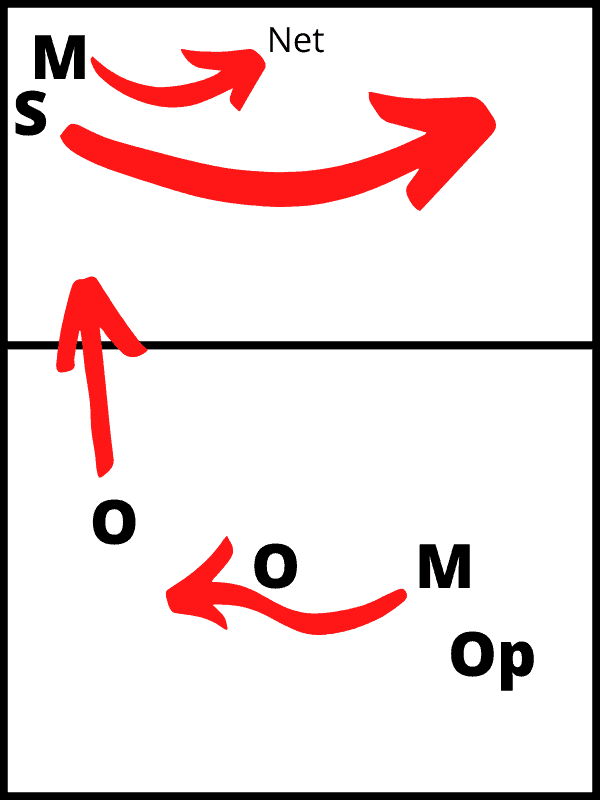
5-1 Serve Receive – Rotation 6
Moving on to the final rotation.
This is it you made it, no more to learn after this one.
As the setter moves to position 3 (Front Middle) they are very close to their base setting position, to make this even easier the middle will move further right to allow the setter to stand in their ideal location.
In the back row we will be hiding the opposite from the pass again, to do this the middle who is at position 5 (Back left) will move right into the middle to pass in place of the opposite.
Again this leaves a gap at position 5 which yep, you guessed it will be filled by the outside player from the front row.
The outside coming back to pass again needs to be mindful not to stand behind the middle they are passing next to.
Once the ball has been served and passed in to the setter the outside will step forward towards position 4 ready to hit, the middle will move in court towards the centre again ready to hit.
In the back row the opposite will run round the outside at position 1 ready for the back row attack and the outside and middle in the back row will both move one position to their left into their base positions.

Every Rotation In Order For the 5-1 Formation
So you have just seen the above and thought
‘What is there more still?’.
Well the short answer is no, don’t worry you have learnt all the rotations however I really want to ensure you know exactly how and when to rotate so using the above diagrams I am going to take you through the full rotation point by point so you can really piece together.
Rotations Walkthrough
The referee calls the captains in before the game starts to run over the game ahead, after the formalities the coin toss takes place and your team captain loses the toss.
The opposition picks to serve first and the game begins.
Your team set’s up in Serve Receive rotation 1

The opposition must be feeling the pressure as they serve in the net and your team gets the point.
The setter is first up to serve for your team, your team sets up in serve rotation 1 ready for the setter to serve,

they float the ball over and the opposition sets the ball up and attacks, the outside hitter for the opposition hits the ball hard off your blockers hands and they win the point for their team.
The opposition step up to serve and your team sets up in serve receive rotation 2

The opposition float the ball over and your team handle it well, putting a good pass into the setter allows the setter to use the middle player on a quick ball catching the opposition off guard and winning the point.
As you rotate one position clockwise it is the outside players turn to serve as the rest of the team gets into serve rotation 2

Unfortunately the outside player serves the ball out the back of the court and the opposition takes the point.
Your team sets up ready to receive in rotation 3.

It must be contagious as the opposition serve the ball out the back of the court too.
Your team moves into serve rotation 3.

Your middle player serves the ball and is picked up by the opposition after a long hard fought rally the opposition forces your team into an error and are awarded the point.
As the opposition set up to serve your team gets into serve reception rotation 4

The opposition serves the ball and it’s another close battle, this time your team comes out on top and wins the point.
As the Opposite steps up to serve your team gets ready to run to their base positions in rotation 4.

The Opposite goes for a jump serve and it lands just out the sideline giving the opposition the point.
The opposition set up ready to serve and your team gets ready to receive in rotation 5.

The opposition’s serve is tough but it is well handled by your team, the setter goes reverse and sets the opposite for a big back row attack, the opposite kills the ball with a big hit.
As your team rotates the outside is up to serve.

The outside serves the ball however it is comfortable for the opposition who get a good pass in and kill the point quickly.
Your team sets up to receive the serve in rotation 6.

In this mostly boring match the opposition makes yet another service area, handing your team the point as you move into your last rotation before repeating.
As the only player left on the court not yet to serve, the middle picks up the ball ready to serve.

The middle serves the ball and gets an ace, unbelievably the first point played where a team has won a point of their own serve.
This starts a surge as your team goes on to win the game not dropping a single point from there on.
Sorry I got a little carried away with the commentary, but hopefully now you know exactly what the 5-1 formation is and more importantly when and how you rotate in this formation.
If you are someone who needs to sit back, watch and listen rather than read you can check out my below videos on how to rotate in this formation.
